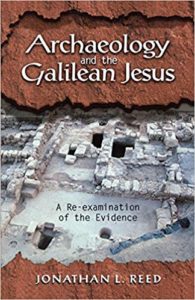In a previous blog post, I talked about what it was like to go On the Road With Jesus.
Jesus took a lot of road trips. He seems to have gone often to the major feasts in Jerusalem (Passover in the spring, Pentecost in early summer, Tabernacles in the fall). It was a long trip to go from his home region of Galilee down to Jerusalem. Each trip must have taken several weeks.
But he also took a lot of local trips inside Galilee.
What was Galilee like?
Galilee Was Small
Galilee was a pretty small region in the time of Jesus. It was roughly circular in shape, and the diameter was just a bit over 30 miles. (In modern Israel, the region known as Galilee covers a bit more land area, but it’s still quite small.)
You could walk from any point in first-century Galilee to any other point in two days. No problem.
Jesus’s hometown was Nazareth, a medium-sized village in the southern part of Galilee. He seems to have made his headquarters in Capernaum, a largish village in the eastern part of Galilee.
And what do I mean by “medium-sized” and “largish?”
You might be surprised.
I’d estimate Nazareth had a population of about 200 to 400 people.
I’d estimate Capernaum had a population of about 1500 to 2000 people.
Those numbers seem awfully small. Where do we get those numbers?
How to Estimate the Population of Ancient Towns
Archaeologists estimate the size of ancient towns and village by looking at two factors:
- The area the town covers.
- Whether the town was walled or unwalled.

Reed’s book says that ancient walled towns had 100 to 150 people per acre, and unwalled towns had about 40 to 60 people per acre. (Why were walled towns denser? Because if a town had walls, everyone wanted to live inside the walls. But once the walls were built, they couldn’t easily be moved, so as time went on, people crowded into them more and more, building multi-story houses until the town had as many people as it could hold.)
So to estimate the population of an ancient town, you have to do enough excavations to determine if it had walls and how much area the town covered.
Big Cities and Small Villages
According to the first-century Jewish historian Josephus, there were 204 villages in Galilee. (Josephus was the general in charge of the defense of Galilee during the Jewish Revolt of A.D. 66-70, so he spent a lot of time there.)
Josephus claims that these villages all had at least 15,000 inhabitants. Assuming all these villages were the same size, first-century Galilee would have had a population of at least 3 million people,.
But that’s very naive on two counts.
- For one thing, we know that the two largest cities in Galilee at the time of Jesus were Tsipori and Tiberias. Each had a population of only about 10,000 people, based on their areas. So all the other towns and villages in Galilee had to be smaller. Historians believe that, like most ancient writers, Josephus wildly inflated his population estimates.
- For another thing, if you look around in your own state or country, you’ll see that cities, towns, and villages have wildly different sizes, from enormously large down to very, very small. It never happens that all the towns have the same size, not even approximately. Large cities are 100 times or even 1000 times larger than small towns.
How To Estimate the Population of Galilee
Still, we can estimate the population of Galilee with reasonable accuracy.
We know that the population of cities and towns roughly follows the famous “80/20 rule.” This rule says that 20% of the cities have approximately 80% of the population. This is what mathematicians call a “power-law distribution.” The math is a little complicated, and I won’t go into it here.
But I wrote a small program on my computer to estimate the populations of all the villages in Galilee using a power-law distribution based on the 80/20 rule. I only needed two numbers:
- The population of the largest city, which is about 10,000.
- The number of cities, towns, and villages, which is about 204.
Using these two numbers, I ran my program and had it print out the theoretical populations of every village, from the largest to the smallest. Please note that this is theoretical. Reality never fits a theory exactly, and nobody expects it to.
The actual numbers would have been a bit different from my calculations, but not enormously different. Usually, the biggest discrepancy between theory and reality comes in the #2 spot. In our case, we know that the #2 city in Galilee was actually just about the same size as the #1 city. So as you’ll see below, the theory is off by about 80% for the #2 city. But we expect the theory to be closer to reality for all the other spots in the calculation.
What we want in this kind of calculation is to get the general trend. Let’s look at a selection of the numbers I calculated.
The Population of Galilee at the Time of Jesus
- The #1 city had a population of about 10,000.
- The #2 city had a population of about 5,504.
- The #3 town had a population of about 3,882.
- The #4 town had a population of about 3,030.
- The #5 town had a population of about 2,500.
- The #6 town had a population of about 2,137.
- The #7 town had a population of about 1,871.
- The #8 town had a population of about 1,668.
- The #9 town had a population of about 1,507.
- The #10 town had a population of about 1,376.
- The #20 town had a population of about 757.
- The #30 town had a population of about 534.
- The #40 village had a population of about 417.
- The #50 village had a population of about 344.
- The #60 village had a population of about 294.
- The #70 village had a population of about 257.
- The #80 village had a population of about 229.
- The #90 village had a population of about 207.
- The #100 village had a population of about 189.
- The #125 village had a population of about 156.
- The #150 village had a population of about 134.
- The #175 village had a population of about 117.
- The #200 village had a population of about 104.
- The #204 village had a population of about 102.
Adding up the numbers for all the cities, towns, and villages gives us an approximate population of Galilee of about 84,000 people.
A Sanity Check on the Numbers
Is that reasonable? In this kind of rough calculation, I’d like to know if the number is good within a factor of 2 or so.
We can do a reality check quite easily. Jonathan Reed’s book says that it took about 2 acres of arable land to feed one person, using the farming methods available in the first-century.
So to feed 84,000 people, Galilee would have needed about 168,000 acres of arable land, which amounts to 262 square miles. Galilee at that time covered about 750 square miles. Some parts of Galilee are very hilly and rocky, so only a fraction of the land is arable. It’s reasonable to think there were at least 262 square miles of arable land.
So it looks like Galilee had enough land to feed 80,000-plus people, but it would have been stretching things to try to feed 200,000. And feeding 3 million would have been wildly out of the question.
This is a good sanity check on our calculations. Our estimate of 84,000 people is the right order of magnitude.
On the Road With Jesus
We can do one final calculation. If Jesus spent about 120 days per year on the road, talking to people in Galilee, could he have met them all?
The answer is yes, in principle. In 3 years, he’d have a total of 360 days to meet people. By interacting with 233 people per day, he could theoretically meet every single Galilean in that time. And 233 is the size of a typical village.
Jesus could spend one day in each of the small and normal-sized villages. Then he’d need to spend considerably longer in the larger towns and cities, but there weren’t many of those.
It’s entirely possible he did exactly that.
Nazareth Was Typical, Capernaum Was Good-Sized
I calculate that if Nazareth had a population of around 200 to 400, then it ranked somewhere between #42 and #94 in the list of all the towns and villages in Galilee. It was a typical-sized village, not enormous, not tiny.
And I calculate that if Capernaum had a population of around 1500 to 2000, then it was somewhere between #6 and #9 on the list. It was larger than most towns, but not as large as the very biggest.
So the story the gospels tells us makes very good sense geographically.
Jesus came from a typical hometown, Nazareth. Not the smallest. Not the largest. Most people in Galilee came from a village much like his.
But Jesus made his headquarters in a somewhat larger town, Capernaum. Not the very biggest he could have chosen, but certainly a prominent town. It’s reasonable to choose a prominent town for your headquarters. Why did Jesus choose Capernaum? Because several of his disciples lived there—Peter, Andrew, James, and John at least. And probably also Thomas and Matthew. Possibly others.
And in the three years Jesus spent traveling around Galilee, he could have interacted with every single person who lived there.

[…] people. That may seem tiny, but in the time of Jesus, it was a respectable size. In my blog post Around Galilee With Jesus, I estimated the sizes of the villages and towns in Galilee to range from around 10,000 down to […]
[…] midsized towns and two large cities. I estimated the total population of Galilee in my blog post Around Galilee With Jesus at about 84,000 […]